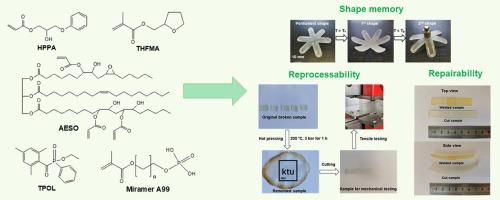European Polymer Journal ( IF 5.8 ) Pub Date : 2023-09-09 , DOI: 10.1016/j.eurpolymj.2023.112424 Sigita Grauzeliene , Anne-Sophie Schuller , Christelle Delaite , Jolita Ostrauskaite

|
The development of sustainable biobased vitrimeric materials is critical for the environment. Herein, UV-curable resins composed of the monomers derived from glycerol, soybean oil, and hemicellulose have been designed and applied in digital light processing (DLP) 3D printing. The use of hemicellulose-derived monomer tetrahydrofurfuryl methacrylate for resins can increase the tensile strength that is used to calculate the reprocessability efficiency. The vitrimeric properties of the resulting polymers such as shape memory, weldability, repairability, and reprocessability have been investigated. The most suitable resin for DLP 3D printing containing a sufficient amount of hydroxyl and ester groups that are essential in transesterification reactions has been selected according to the results of the real-time Fourier transform infrared spectroscopy and real-time photorheometry measurements. By activating dynamic transesterification reactions at elevated temperatures, the 3D printed samples exhibited shape memory, repairability, and reprocessability properties. A recovery ratio of 100 %, repairability with improved tensile strength by 2 times, and a recycling efficiency of 344 % was reached by incorporating tetrahydrofurfuryl methacrylate into the resins. The recycling efficiency achieved is 10 times higher compared to a similar vitrimer based on glycerol and soybean oil.
中文翻译:

由丙烯酸2-羟基-3-苯氧基丙酯、甲基丙烯酸四氢糠酯和丙烯酸酯化环氧化大豆油合成的生物基vitrimer,用于数字光处理3D打印
可持续生物基玻璃材料的开发对环境至关重要。本文设计了由甘油、大豆油和半纤维素单体组成的紫外固化树脂,并将其应用于数字光处理(DLP)3D打印。将半纤维素衍生的单体甲基丙烯酸四氢糠酯用于树脂可以提高用于计算可再加工效率的拉伸强度。研究了所得聚合物的玻璃体性能,例如形状记忆、可焊接性、可修复性和可再加工性。根据实时傅里叶变换红外光谱和实时光流变测量的结果,选择了最适合 DLP 3D 打印的树脂,该树脂含有足够量的酯交换反应必需的羟基和酯基。通过在高温下激活动态酯交换反应,3D 打印的样品表现出形状记忆、可修复性和可再加工性。通过将甲基丙烯酸四氢糠酯掺入树脂中,回收率达到了 100%,可修复性提高了 2 倍,拉伸强度提高了 2 倍,回收效率达到了 344%。与基于甘油和大豆油的类似 vitrimer 相比,所实现的回收效率高出 10 倍。通过在高温下激活动态酯交换反应,3D 打印的样品表现出形状记忆、可修复性和可再加工性。通过将甲基丙烯酸四氢糠酯掺入树脂中,回收率达到了 100%,可修复性提高了 2 倍,拉伸强度提高了 2 倍,回收效率达到了 344%。与基于甘油和大豆油的类似 vitrimer 相比,所实现的回收效率高出 10 倍。通过在高温下激活动态酯交换反应,3D 打印的样品表现出形状记忆、可修复性和可再加工性。通过将甲基丙烯酸四氢糠酯掺入树脂中,回收率达到了 100%,可修复性提高了 2 倍,拉伸强度提高了 2 倍,回收效率达到了 344%。与基于甘油和大豆油的类似 vitrimer 相比,所实现的回收效率高出 10 倍。





















































 京公网安备 11010802027423号
京公网安备 11010802027423号